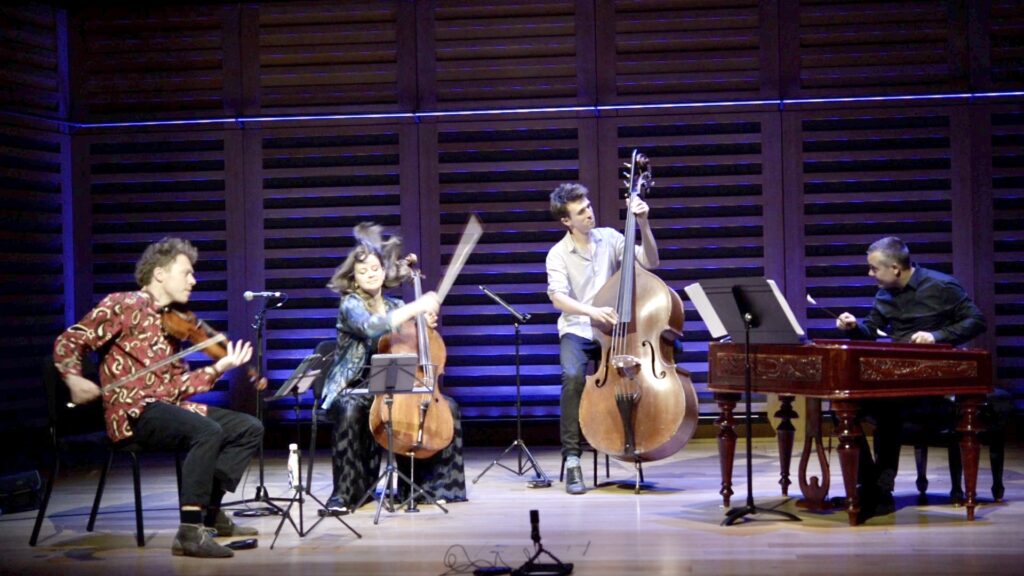Many thanks to everyone who attended our sold out concert at Crown House on October 3rd and to Victoria Kingham at Hastings Independent Press for this review.
Hungarian Rhapsody
Those of you who have kindly read the music reviews here over the past year or so, will have read of the brilliance and originality of local virtuoso Max Baillie and his musical enterprise, St Leonards Concerts. The surprises continue, the project goes from strength to strength, and I am running out of superlatives.
The concert on 3 October at Crown House was no exception. This time it was curated by cellist Laura van der Heijden, who at the age of 15 won the BBC Young Musician of the Year award and is fast emerging as one of the most gifted musicians of her generation. She shows not only peerless musicianship – at the age of twenty-six she has performed with most of the world’s top orchestras and conductors – but creativity in her musical programming, breadth as well as depth of knowledge and skill.
This isn’t the first time that she has performed with Max Baillie, and there are two or three spirited videos on YouTube of them playing together. But she recently came across the musician Marcel Comendant, a cimbalom player, who, in common with his chosen instrument, is not nearly so well-known as he should be outside his native Hungary.
Cimbalom Brilliance
The cimbalom was first invented and constructed in the 1850s as a development of a folk instrument, the Hungarian dulcimer. The newer cimbaloms have detachable legs for (relative) ease of transport and reassembly. It looks like a small piano but is elaborately strung, and played with soft hammers. It has a fairly complex tuning scheme with harmonic resonators, like a kind of table-top zither. Comendant’s instrument is a lacquered dark red, which was oddly, but pleasantly, in keeping with the 30s nightclub décor, red velvet curtains, and Chinese lanterns at Crown House Regency Rooms.
Van der Heijden has always had an interest in European folk music, and Hungarian folk music particularly, since she heard Comendant on an EP and thought he “sounded really cool”. She wanted to make music with him, “and here he is!” Among musicians of this calibre, “really cool” seems a laughably understated way of saying well, he is versatile enough, brilliant enough. The man is clearly born to his instrument. The arrangements were interesting, since two of the numbers were bass player Mullov-Abbado’s rather fine compositions, and it was the first time they had all performed in public together. “Well actually, all the arrangements are really sketchy,” Mullov-Abbado admitted. I wondered about the cimbalom part. “He mainly just does his own thing – he does his own thing all the way through really.”
European Eclecticism
It’s probably this lack of written precision that makes for the group’s clear and absolute enjoyment of playing together, the unexpectedness of not knowing, for example, what each musician will play in the cadenza sections or indeed the improvised sections in some of the tunes. And what tunes! An inspired mix of broadly folk-related melodies, European except for two which were sung, unexpectedly and vividly, by van der Heijden: Jobim’s Águas De Março (made popular by Art Garfunkel back in the mists of time as The Waters of March, but written well before and recorded by several jazz greats), and the great Nature Boy. This tune was immortalised by Nat King Cole long ago and attributed to Brooklyn’s original nature boy, Eden Ahbez. It turns out in fact to have been plagiarised from a song written by Yiddish composer Herman Yablokoff, who in turn adapted it from a Yiddish folk tune, so it’s Eastern European after all. There was another Hungarian piece by György Kurtág, with melodies and harmonies as complex as the Hungarian language, and a wonderful medley of Bach and Bartók (put together by Baillie). Pieces by De Falla and Ravel came interspersed with Mullov-Abbado’s compositions, and the opening piece was a violin sonata written by French composer Elisabeth Jacquet de La Guerre more than three hundred years ago.
So, I began by saying I had run out of superlatives. It’s impossible to praise the skill of these musicians too highly, and if you see them together, you’ll immediately realise why. Just as great is their seamless and joyous presentation of this fine admixture of material and the scholarship which enables it. They are part of a movement which presents great music without barriers and without genre preconceptions. Indeed one of Misha Mullov-Abbado’s albums is appropriately titled Cross Platform Interchange. It’s a fine and beautiful eclecticism.
Laura van der Heijden: cello, Max Baillie: violin, Misha Mullov-Abbado: double bass, Marcel Comendant: cimbalom appeared on Tuesday 3 October as part of the St. Leonards Concerts series

